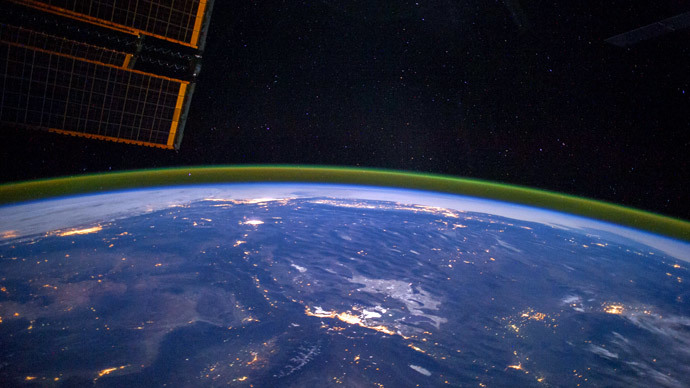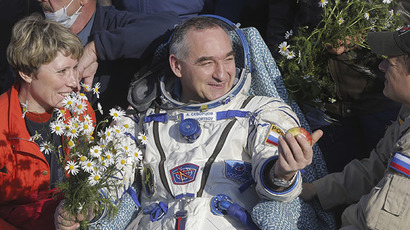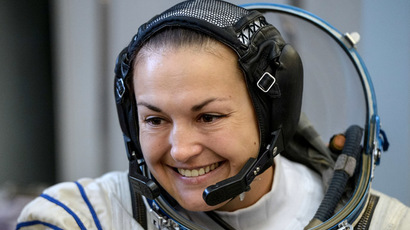Out of ISS: Russia going solo with space station?

The Russian space agency is reportedly considering construction of a high-altitude orbital station starting from 2017. This means that Moscow may walk away from the ISS after 2020, when its obligations under the current project are fulfilled.
Kommersant newspaper reported that the manned space exploration program for the period until 2050 implies step-by-step assembly of a new scientific space station, citing its sources in Central Research Institute for Engineering Technology, Roscosmos space agency’s leading space scientific and research enterprise.
The principal difference from the currently operating International Space Station will be the new Russian station’s high-altitude orbit with a 64.8-degree inclination, which would make up to 90 percent of the Russian territory visible from on board, including Arctic shelf seas.
From the ISS, which has an orbit inclination of 51.6 degrees, no more than 5 percent of the Russian territory is currently visible.
Additionally, the new station will be better positioned for manned flights from Russia’s under-construction Vostochny Cosmodrome, which will see the first rocket launch in the end of 2015.

A manned flight from Vostochny to the ISS, were it to happen today, would bear a certain risk in case of an emergency cancelation of a mission. In that case the flight trajectory would see the module come down in open sea, whereas for the new station it would fall over land, Kommersant reports.
The Plesetsk Military Cosmodrome in Russia’s north will also become handy for delivery of cargo to the new space station. The use of the old Soviet Baikonur Cosmodrome in Kazakhstan will continue as usual.
“The initial configuration will consist of a node module mated with multipurpose research module and space laboratory OKA-T,” Kommersant quotes an unnamed source in the Central Research Institute for Engineering Technology.
The station will be maintained with new rocket boosters under development: Progress-MS (first launch – latter half of 2015) and Soyuz-MS (first launch May 2016).
Once the station is functioning, Roscosmos is planning to run there trials of an energy and transformer modules for a future lunar program.
“In fact we are talking about creating a bridgehead: first space hardware will be delivered to the station, then it will be going to the moon,” the source said.
The new manned space exploration program is being readied by scientific institutes united under Roscosmos.
The Central Research Institute for Engineering Technology declined to comment to RT regarding the construction of a new space station.
Roskosmos is considering several options for a new national space station to replace the ISS, Denis Lyskov, the federal space agency’s official secretary, confirmed to Itar-TASS news agency.
“We’re considering a number of options,” Lyskov said.
Without going into details, Lyskov criticized news about the station already circulating in the media.
“Premature options should not be given to the media,” Lyskov stressed.
Deputy Prime Minister Dmitry Rogozin announced in May that Roscosmos receives little commercial payback from the International Space Station, despite spending up to 30 percent of its annual budget on the project.
“Our profit is flat low… so we see no business interest in it [going on with the ISS],” Rogozin said, adding that Russia is set to fulfill its international obligations regarding the ISS.

"There are rumors about Russia leaving the ISS project. We will not, the program is set to run until 2020 and we will stick to our international obligations. As for prolonging it till 2024 – that’s what we’re really doubtful of," Rogozin stressed.
Last week Roscosmos head Oleg Ostapenko told NASA administrator Charles Bolden at the Airshow China exhibition that the decision on further use of the ISS after 2020 will be made by the end of the year.
The US space industry, which uses Russian Soyuz vehicles to deliver its astronauts to the ISS, insists on using the ISS until at least 2024. Other participants in the project, such as Japan, have also expressed interest in sustaining operability of the station for a longer period.
In 2013, the US spent $3 billion on the ISS, six times more than Roscosmos allocated for the station, whereas Russia has the right to form half of the ISS crew.
The ISS project was initiated in 1998, with Russia contributing the first modules needed for its construction. Before the ISS, Roscosmos operated its own Soviet-era MIR station, which remained operational for 15 years, from 1986 to 2001, before it was de-orbited and sank in the Pacific Ocean.















